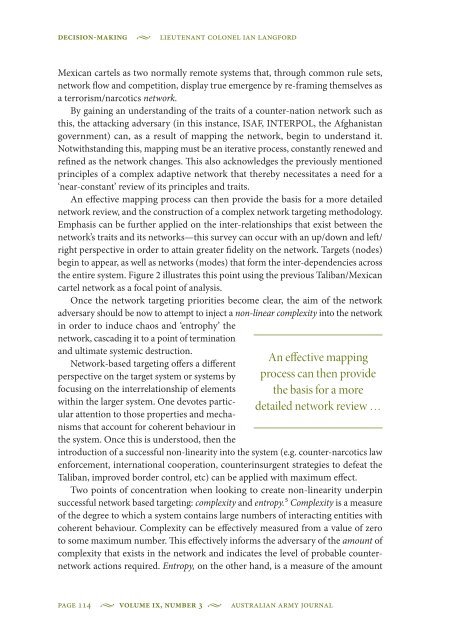Understanding and Defeating a Complex Adaptive ... - Australian Army
Understanding and Defeating a Complex Adaptive ... - Australian Army
Understanding and Defeating a Complex Adaptive ... - Australian Army
Create successful ePaper yourself
Turn your PDF publications into a flip-book with our unique Google optimized e-Paper software.
Decision-Making • Lieutenant Colonel Ian Langford<br />
Mexican cartels as two normally remote systems that, through common rule sets,<br />
network flow <strong>and</strong> competition, display true emergence by re-framing themselves as<br />
a terrorism/narcotics network.<br />
By gaining an underst<strong>and</strong>ing of the traits of a counter-nation network such as<br />
this, the attacking adversary (in this instance, ISAF, INTERPOL, the Afghanistan<br />
government) can, as a result of mapping the network, begin to underst<strong>and</strong> it.<br />
Notwithst<strong>and</strong>ing this, mapping must be an iterative process, constantly renewed <strong>and</strong><br />
refined as the network changes. This also acknowledges the previously mentioned<br />
principles of a complex adaptive network that thereby necessitates a need for a<br />
‘near-constant’ review of its principles <strong>and</strong> traits.<br />
An effective mapping process can then provide the basis for a more detailed<br />
network review, <strong>and</strong> the construction of a complex network targeting methodology.<br />
Emphasis can be further applied on the inter-relationships that exist between the<br />
network’s traits <strong>and</strong> its networks—this survey can occur with an up/down <strong>and</strong> left/<br />
right perspective in order to attain greater fidelity on the network. Targets (nodes)<br />
begin to appear, as well as networks (modes) that form the inter-dependencies across<br />
the entire system. Figure 2 illustrates this point using the previous Taliban/Mexican<br />
cartel network as a focal point of analysis.<br />
Once the network targeting priorities become clear, the aim of the network<br />
adversary should be now to attempt to inject a non-linear complexity into the network<br />
in order to induce chaos <strong>and</strong> ‘entrophy’ the<br />
network, cascading it to a point of termination<br />
<strong>and</strong> ultimate systemic destruction.<br />
Network-based targeting offers a different<br />
perspective on the target system or systems by<br />
focusing on the interrelationship of elements<br />
within the larger system. One devotes particular<br />
attention to those properties <strong>and</strong> mechanisms<br />
that account for coherent behaviour in<br />
the system. Once this is understood, then the<br />
An effective mapping<br />
process can then provide<br />
the basis for a more<br />
detailed network review …<br />
introduction of a successful non-linearity into the system (e.g. counter-narcotics law<br />
enforcement, international cooperation, counterinsurgent strategies to defeat the<br />
Taliban, improved border control, etc) can be applied with maximum effect.<br />
Two points of concentration when looking to create non-linearity underpin<br />
successful network based targeting: complexity <strong>and</strong> entropy. 5 <strong>Complex</strong>ity is a measure<br />
of the degree to which a system contains large numbers of interacting entities with<br />
coherent behaviour. <strong>Complex</strong>ity can be effectively measured from a value of zero<br />
to some maximum number. This effectively informs the adversary of the amount of<br />
complexity that exists in the network <strong>and</strong> indicates the level of probable counternetwork<br />
actions required. Entropy, on the other h<strong>and</strong>, is a measure of the amount<br />
page 114 • Volume IX, Number 3 • <strong>Australian</strong> <strong>Army</strong> Journal

















